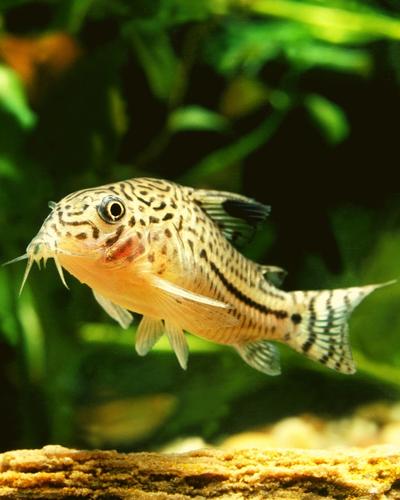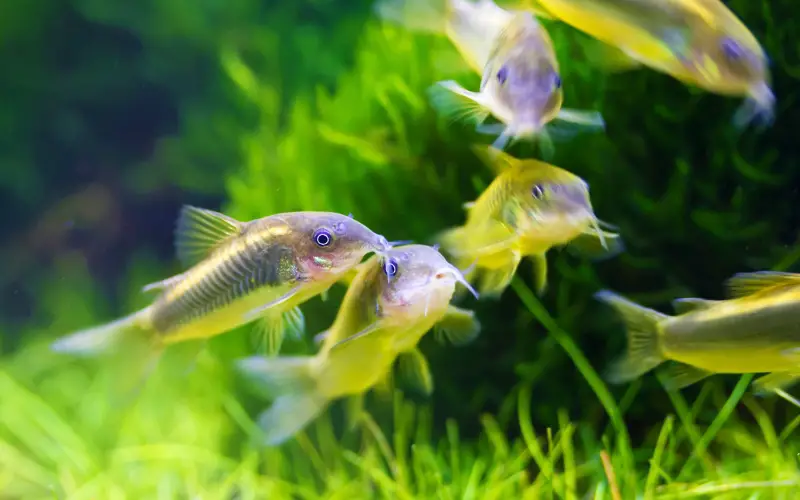If you’re an aquarium enthusiast, you’ve encountered the delightful Cory catfish behavior. These small, bottom-dwelling fish are known for their unique habits and captivating antics.
Cory catfish are popular freshwater aquarium fish known for their peaceful and shoaling behavior. However, some Cory catfish behavior may seem strange or even alarming to new aquarists.
In this Cory catfish care guide, we will explore some of the most unbelievable Cory cat behavior and discuss whether it is good or bad for your tank, from their natural habitat to their care requirements.

We’ll also dive into their intriguing behavior and answer whether it is good or bad.
So Let’s embark on this aquatic adventure and discover the fascinating world of Cory Catfish.
Table of Contents
ToggleWhat is Normal Cory Catfish Behavior?
Cory catfish are naturally bottom-dwelling fish that prefer scavenging for substrate food. They are also social creatures and choose to live in groups of at least five fish.
Cory catfish are generally peaceful tropical fish but can become aggressive if overcrowded or stressed.
What are some of the most Strange Cory catfish behaviors?
- Cory catfish “dancing”: This behavior is often seen when Cory catfish are excited or stressed. The fish swim around in a jerky, erratic manner, constantly rubbing their bodies against the substrate.
- Cory catfish “barbel grazing”: Cory catfish have barbels, which are sensitive feelers that help them find food. Sometimes, Cory catfish will rub their barbels against the substrate or other objects in bottom of the tank. Corydoras behavior is thought to help them remove parasites and debris from their barbels.
- Cory catfish “gulping air” can breathe air from the water’s surface. Sometimes, you may see them gulping air at the surface. This is usually not a cause for concern, but it can indicate low oxygen levels in the tank.
Is Albino Cory Catfish Behavior Good or Bad?
Most of the behaviors listed above are normal and harmless. However, if you notice any unusual or aggressive behavior in your Cory catfish, it is essential to investigate the cause. Some possible causes of abnormal cory catfish behavior include:
- Overcrowding
- Stress
- Poor water quality
- Illness
If you are concerned about your Cory cat behavior, consulting with an experienced aquarist is always best.
Cory Catfish: The Charming Bottom Dwellers
Cory Catfish, scientifically known as Corydoras, are a group of small freshwater fish native to South America. They are a popular choice among aquarists for their peaceful nature, unique appearance, and, of course, their extraordinary behavior.
Exploring Cory Catfish Behavior
– The Gulp of Air Mystery
One of the most remarkable behaviors exhibited by Cory Catfish is their occasional gulp of air from the water’s surface. You might wonder if this is normal for a fish. Well, it’s perfectly normal for Cory Catfish. These fish possess a modified stomach that allows them to extract oxygen from the air, making them well-suited for environments with lower oxygen levels.
– Corydoras Feed on a Variety Foods
Cory Catfish are not picky eaters. They feed on various foods, including live or frozen options like brine shrimp, daphnia, bloodworms, and high-quality pellets and flakes. This versatility in their diet makes them easy to care for in an aquarium setting.
In their natural habitat, Cory catfish have a diverse diet of insects, worms, crustaceans, and plant matter, such as decaying leaves from aquatic plants.
– The Social Side: Kept in Groups
Cory Catfish are social creatures, and they thrive when kept in groups. It’s recommended to have at least six Cory Catfish in your tank. Watching them interact and explore their environment is a joy for any aquarium owner.
Cory Catfish Care
Cory catfish are popular for community aquariums because they are hardy, peaceful, and relatively easy to care for. Here are some tips for keeping cory catfish healthy and happy:
- Cory Catfish Tank size: Cory cats require at least a 20-gallon tank, but larger one is always better. They are active fish and need plenty of space to swim and explore.
- Water parameters: Cory catfish prefer soft, slightly acidic water with a pH of 6.5-7.5 and a temperature of 72-78 degrees Fahrenheit. The water should be well-filtered and aerated.
- Substrate: Cory catfish have sensitive barbels and need a soft tank substrate like sand or fine gravel. Avoid sharp or jagged rocks.
- Decorations: Cory catfish appreciate hiding places, so add plants and decorations to their tank. Driftwood and rocks are also good options.
- Tankmates: Cory catfish are peaceful fish that can be kept with other community fish. However, avoid keeping them with aggressive fish that might nip at their fins.
- Diet: Corydoras catfish are omnivores and will run through a variety of foods. They should be fed a diet of sinking pellets, live or frozen foods, and algae wafers.
- Water changes: partial water changes of 25-30% are essential to keep the water quality high for cory catfish.
With proper care and attention, Cory catfish can thrive for 10-15 years or more. They are an excellent addition to any community aquarium and will bring you years of enjoyment.
Here are some additional tips for caring for cory catfish:
- Feed them various fish foods to ensure they get all the necessary nutrients.
- Refrain from feeding them, as this can lead to water quality problems.
- Keep an eye on their barbels. If they start to erode, it could be a sign of poor water quality or a bacterial infection.
- Separate any new fish before adding them to the tank with your cory catfish.
With proper care, cory catfish are hardy and easy-to-care-for fish that will make a great addition to your aquarium.
Creating the Perfect Home Aquarium
– Tank Size Matters
When setting up a tank for Cory Catfish, consider a minimum size of 20 gallons. This provides ample space for them to swim and explore. Additionally, ensure the tank has a secure lid to prevent any adventurous Corys from leaping out.
– Ideal Water Conditions
Maintaining the correct water parameters is crucial for the well-being of your fish. Cory Catfish prefer slightly acidic to neutral water with a pH level of 7.0. Ensure stable temperature and water hardness to keep your fish healthy and stress-free.
– Hiding Spots and Tank Mates
Cory Catfish appreciate hiding spots in the form of plants, caves, or decorations. They also make great tank mates for peaceful fish species like tetras and rasboras. Avoid aggressive or nippy tank mates that might stress out your Corys.
Breeding Cory Catfish: A Rewarding Experience
Cory catfish Breeding Behavior and Season
Cory Catfish have a breeding season during which they exhibit unique behaviors. Males often dart to the surface and gulp air before racing back down, displaying their readiness to spawn. Breeding Corydoras Catfish can be a rewarding experience for dedicated aquarists.
Caring for the Fry
Once the eggs are laid and fertilized, providing a separate tank for the fry is crucial, as adult Corys might consume their offspring. Proper care and feeding are essential to ensure the young Corys grow strong and healthy.
Is Cory Catfish Behavior Good or Bad?
The behavior of Cory catfish species is undeniably good. Their unique antics and social nature make them a delightful addition to any aquarium.

Their ability to gulp air, diverse diet, and hardy nature make them relatively easy to care for, even for beginners.
Furthermore, their peaceful temperament and compatibility with other fish species make them an excellent choice for community tanks.
Commonly Asked Questions about Corydoras Catfish Care (FAQs)
Can Cory Catfish be kept with aggressive fish species?
It’s best to avoid aggressive tank mates as they can stress out your Cory Cats. Stick to peaceful fish species.
Do Cory Catfish require a specific water temperature?
They prefer a stable water temperature around 72-78°F (22-26°C).
How many Cory Catfish should I keep together?
Keeping them in groups of at least six is recommended for their social well-being.
Are Cory Catfish suitable for beginners?
Yes, they are considered beginner-friendly due to their hardy nature and ease of care.
Can Cory Catfish live in a community tank?
They are great additions to community tanks, provided their tank mates are peaceful.
Do Cory Catfish require unique hiding spots in the aquarium?
They appreciate hiding spots like plants or decorations, which also serve as resting places.
What is Cory Catfish Behavior?
Cory Catfish Behavior refers to the specific behavior patterns exhibited by different species of Corydoras catfish in an aquarium setting.
What kind of fish are Cory Catfish?
Cory Catfish are a kind of freshwater fish belonging to the Corydoras genus.
Do Cory Catfish eat algae?
Yes, Cory Catfish are known to eat algae as part of their diet.
What are good tank mates for Cory Catfish?
Good tank mates for Cory Catfish include peaceful community fish such as Neon tetras, rasboras, and guppies.
What are the recommended water conditions for Cory Catfish?
Cory Catfish prefer a pH range of 6.0 to 8.0 and a temperature range of 73°F to 78°F.
How big do Cory Catfish grow?
The size of Cory Catfish can vary depending on the species, but they generally reach a size of 2 to 3 inches.
What is the diet of Cory Catfish?
Cory Catfish are omnivorous and eat various foods such as flake, shrimp pellets, and even live or frozen foods such as brine shrimp.
Are Cory Catfish hardy fish?
Yes, Cory Catfish are hardy fish that adapt well to different water conditions.
Can Cory Catfish be kept with shrimp?
Yes, Cory Catfish can generally be kept with shrimp without any issues as long as the shrimp are not too small to be seen as prey.
What are some popular species of Cory Catfish?
Some popular species of Cory Catfish include the Corydoras julii, Corydoras panda, Corydoras bronze, and Albino Corydoras.
Final Thoughts
In conclusion, understanding the fascinating world of aquarium fish can be both educational and rewarding. These aquatic creatures never amaze us, from their vibrant colors to their unique behaviors. And when it comes to Cory cat behavior is genuinely captivating. Whether observing their playful antics or witnessing their synchronized swimming, these little bottom-dwellers bring a sense of charm and harmony to any tank. So, if you’re an aquarium enthusiast looking to add life and personality to your aquatic ecosystem, remember to explore the wonderful world of Cory catfish behavior.
You might also like
- Cory Catfish With Betta Fish: 5 Surprising Secrets for Success!
- How Many Cory Catfish Can Go in a 10 Gallon Tank: (Shocking Truth)
- Cory Catfish Surfing Glass: (Reasons & 5 Rapid Solutions)
- False Julii Cory Vs Julii Cory: 3 Ways to Spot Them Apart!
- How Big Do Albino Cory Catfish Get? (A Comprehensive Guide)
- Are Albino Cory Catfish Blind? Let’s Clear Up the Confusion
- Cory Catfish Laying on Side: (Top 5 Reasons & Solutions)
- 7 Best Types of Catfish for Aquarium: Boost Your Tank Beauty
- Can Cory Catfish Live Without Air Pump: Here’s How They Do It!
- Are Cory Catfish Poisonous: 5 Proven Ways to Tame Them!
- Cory Fish Swimming Up and Down Glass: Reasons & Solution
- Panda Corydoras 101: Unlock the Secrets of Cory Panda Fish!




